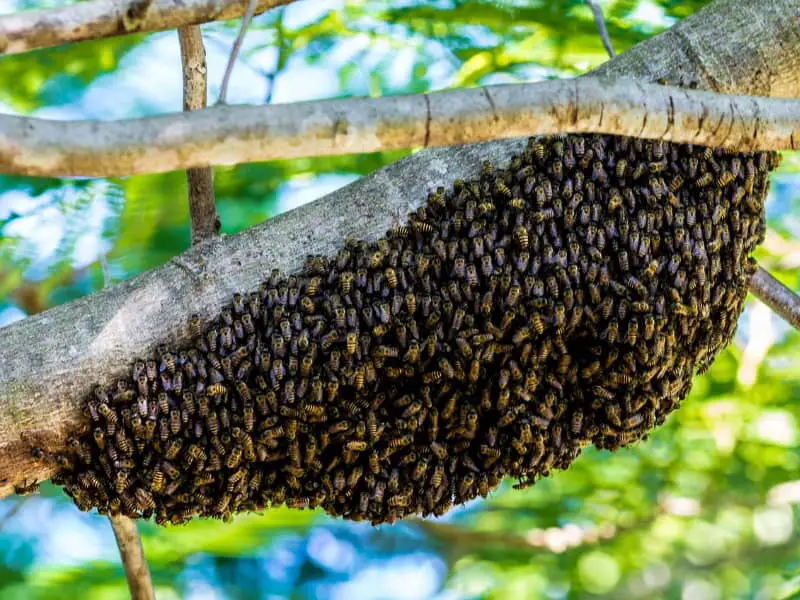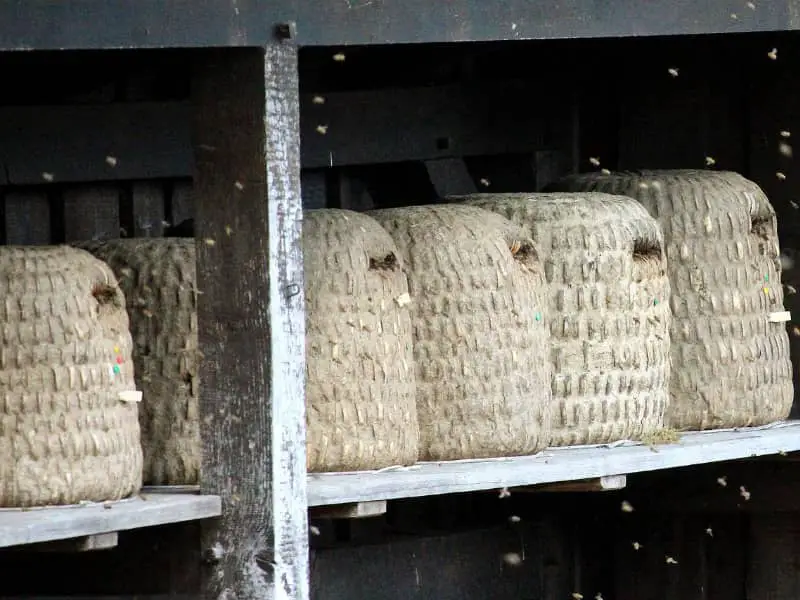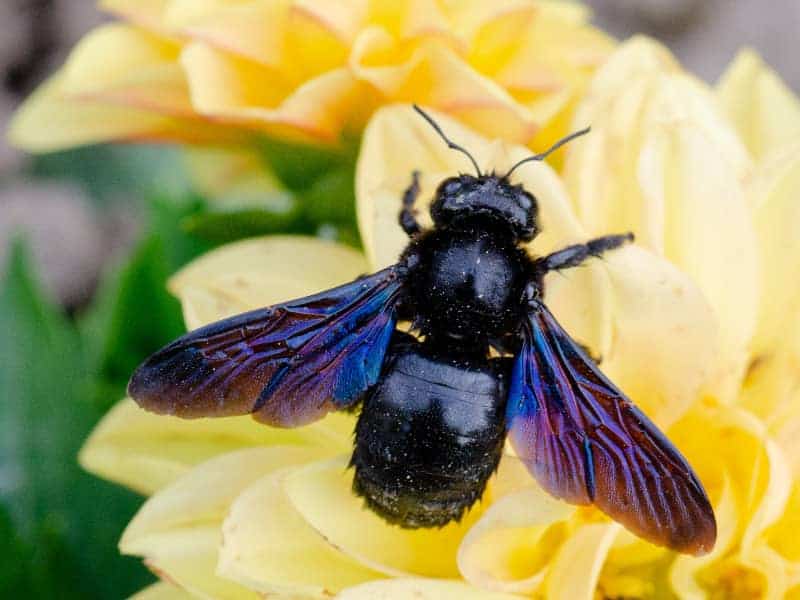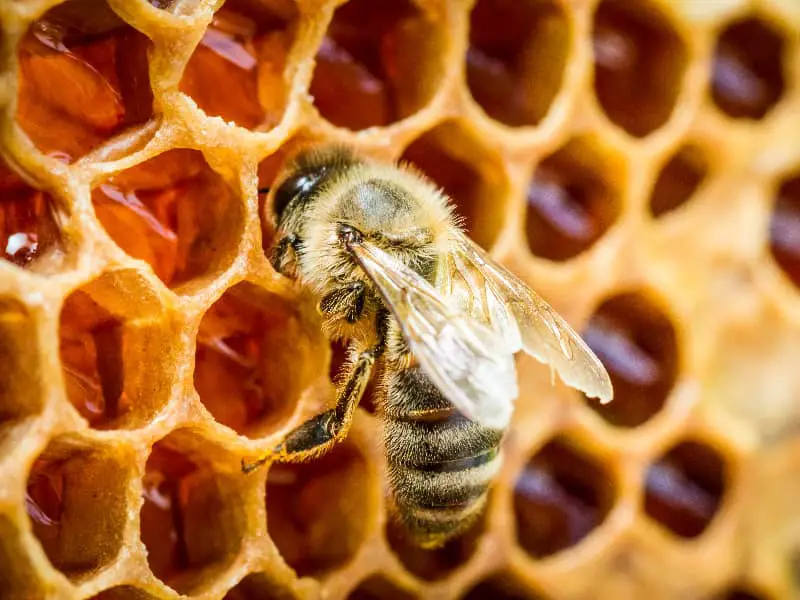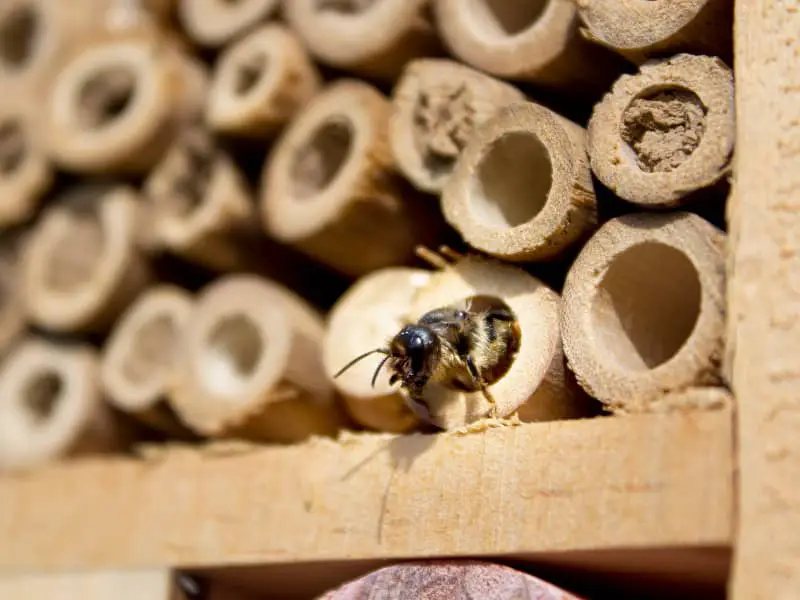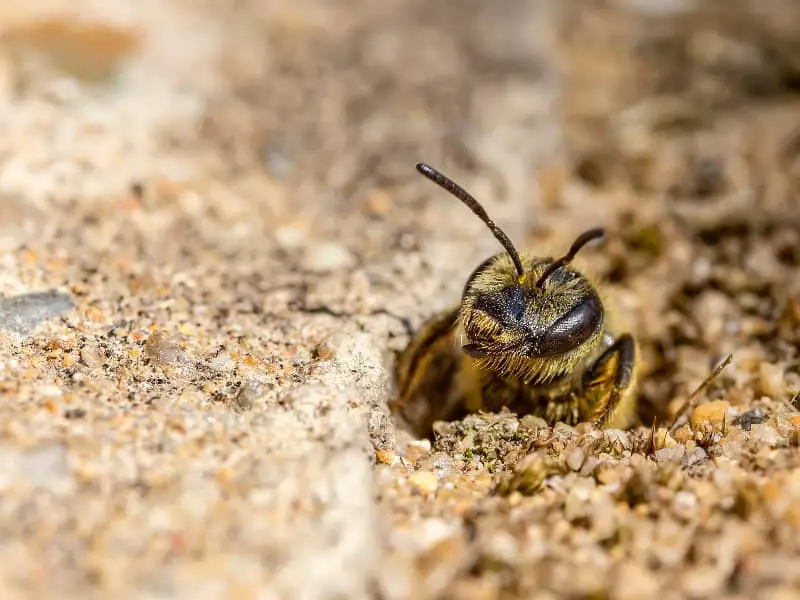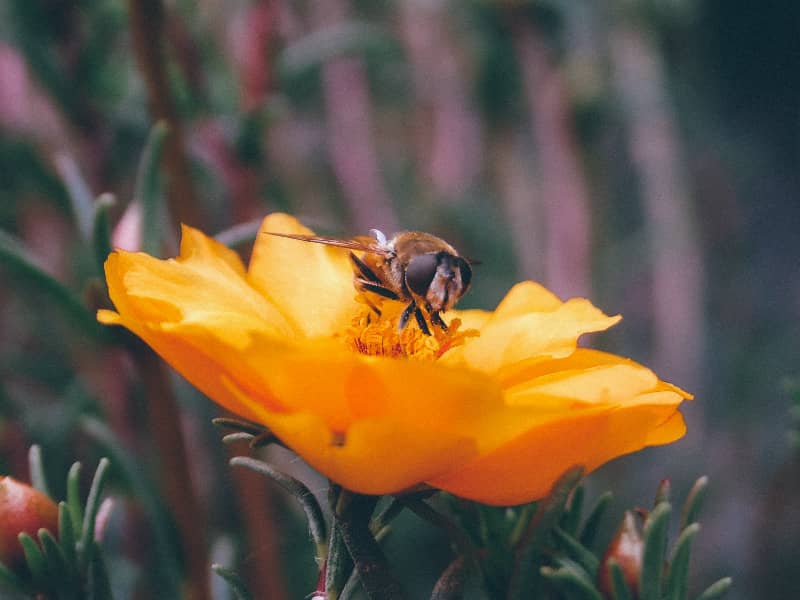
Bees with proboscis
When you think of bees, their black and yellow stripes and their important role in nature immediately come to mind. But have you ever thought about the fact that bees have a proboscis? This small but essential organ allows bees to ingest food and thus contributes to their survival. But what exactly is the proboscis? How does it work and what role does it play in the bees' lives? Dive with us into the fascinating world of bees and their proboscis.
Bees with proboscis what is it for?
Basically, a bee's proboscis is a complex organ that primarily serves to suck up nectar from flowers. It is an extendable and flexible tube system. It allows the bee to dive deep into flower calyxes to reach its food.
The importance of the proboscis for the bee is enormous. It enables it not only to feed, but also to collect nectar. This nectar is later processed into honey in the hive. Without proboscis, bees could therefore neither collect nectar nor produce honey.
Bees with proboscis, how it built the proboscis?
The proboscis of a bee is a marvel of nature. It consists of several parts that work perfectly together. The main components are the labium and labrum, which can be compressed. Between them are two mandibles that protect and stabilize the proboscis.
The internal structures of the proboscis are responsible for nectar transport. They ensure that the nectar is efficiently picked up and passed on. If you watch a bee collecting nectar, you can see the proboscis in action. It is inserted into the flower and the nectar is sucked up.
Can all bee species pick up nectar with their proboscis?
There are over 20,000 known bee species worldwide. But not all of them have the same capabilities when it comes to their proboscis. While many bee species can pick up nectar with their proboscis, there are some that specialize in other food sources.
Some bee species have a very short proboscis. This limits their ability to suck nectar from deeper flowers. Therefore, they concentrate on superficial food sources. Other bee species have a particularly long proboscis, which enables them to penetrate deeper flowers and access nectar sources that are inaccessible to other species.
Are there any dangers for the bee's proboscis?
Even though the proboscis is a robust organ, it is not invulnerable. There are several factors that can harm it. One common problem is pollution. Residues of pesticides and other chemicals can gum up the proboscis.
A glued proboscis can be devastating for a bee. It can no longer efficiently ingest nectar. It cannot survive for long without ingesting food. Furthermore, a damaged proboscis can affect communication in the hive, as bees communicate with each other through dance and scent.
It is therefore crucial to keep our environment clean and minimize the use of harmful chemicals. Only in this way can we ensure that bees can continue to make their important contribution to nature and our food supply.
How do bees clean their proboscis?
Hygiene is very important for bees. After collecting nectar, they need to clean their proboscis. They do this by moving it in and out several times. This wipes off the nectar and cleans the proboscis.
Sometimes bees also help each other clean. They use their mandibles and legs to clean the proboscis of another bee. This social behavior shows how important the community is for the survival of the hive.
Cooperation and care are essential in a hive. Each bee has its specific role and task to ensure the well-being of the community. Cleaning the proboscis is just one of many tasks that are part of the bees' daily life.
The evolution of the proboscis: why did bees develop it?
Evolution is a constant process of change and adaptation. For bees, the proboscis has emerged as an efficient means of foraging. But how did it come about?
The ancestors of bees were probably carnivorous insects. They had powerful mandibles to crush their prey. However, when these insects began to feed on pollen and nectar, a more specialized organ was needed for feeding. The proboscis evolved in response to this new way of feeding.
The evolution of the proboscis allowed bees to more efficiently pick up nectar and transport pollen. This led to a close relationship between flowers and bees. Bees helped with pollination, while flowers provided them with food. This symbiosis was perfected over millions of years and has greatly shaped the diversity of the plant world as we know it today.
Adaptation of the beehive to different types of flowers
Bees are wonderful examples of nature's adaptability. Their proboscis has adapted to different types of flowers over time. Depending on which flowers a bee species takes nectar from, the proboscis can vary.
Some bee species, such as long-tailed bees, can penetrate deeply into tubular flowers with their long proboscis. Other species have shorter proboscises that are more suited to shallow flowers. This diversity allows different bee species to live in the same areas without being in direct competition with each other. They use different flower sources, reducing competition for food.
How important is the bee proboscis for pollination?
Pollination is a central process in the plant world. It enables plants to reproduce and exchange genetic material. Bees play a key role in this process. But what role does the proboscis play in this process?
While the proboscis is mainly used for feeding, it often comes into contact with pollen. This happens when the bee dives into a flower to suck nectar. The pollen remains attached to the proboscis and the bee's body. When the bee visits the next flower, some of this pollen is transferred to the flower. This unintentional pollen transfer is crucial for the pollination of many plant species.
Even though the proboscis was not developed directly for pollination, it still has an indirect influence on it. By foraging, bees contribute to the reproduction and spread of many plants.
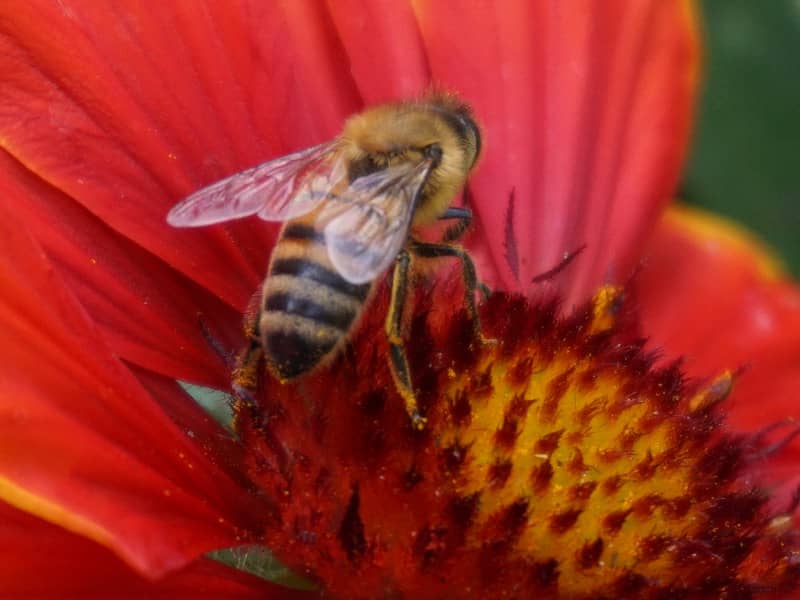
The proboscis in bee communication
Communication is of central importance in the hive. Bees use various methods to communicate with each other. One of the best known is the bee dance, in which one bee tells others the location of a food source. But does the proboscis also play a role in this communication?
Yes, it does. The proboscis is used not only for food intake, but also for communication within the hive. Bees share food with each other by transferring nectar from one proboscis to another. This process, also called "trophallaxis," is not only a form of food sharing, but also a way to exchange information about food sources or the condition of the hive. It is another example of how central the proboscis is in the life of bees.
Bee with proboscis and environmental changes
In an ever-changing environment, bees must continuously adapt to new challenges. Climate change, habitat loss and the spread of invasive plant species are just some of the factors that affect the lives of bees. But how does this affect the proboscis and its function?
In some regions, it is becoming apparent that bees need to adapt to new plant species that are encroaching on their territory. If these new plants have flowers with different shapes or depths, this may affect the bees' ability to collect nectar. Bees whose proboscis is not suited to extracting nectar from these new flowers may have difficulty finding sufficient food.
However, there is evidence that bees can adapt evolutionarily to such changes. In some areas, bee populations with longer proboscises have an advantage over those with shorter proboscises because they are better adapted to the predominant flower shapes. This evolution, while slow, demonstrates the adaptability of bees.
Man and the bee proboscis
Human activities have a profound impact on the environment and the organisms that live in it. Agriculture, urban development and pesticide use are just some of the factors that directly affect bees. But how do these human interventions affect the bees' proboscis?
A major problem for bees is pesticide use in agriculture. Some of these chemicals can gum up the proboscis or impair its function. Such impairment can significantly reduce the bees' ability to collect nectar and communicate.
Landscape change can also have an impact. When traditional food sources are displaced by human activities, bees must turn to new plant species. In the long term, this could lead to evolutionary changes in proboscis structure.
So it is crucial that when we think about bees and their role in the environment, we also consider the interactions with human activities. Because what we do today can affect bees and their evolution in the future.
Trunk technology: Inspired by nature
The study of nature has often led to groundbreaking technological developments. The proboscis of bees, with its precision and efficiency, has also attracted the interest of scientists and engineers. They wonder: What can we learn from this amazing organ?
Technologies inspired by the structure and function of the bee's proboscis have already been developed in the fields of robotics and medical technology. These artificial "proboscises" could find application in minimally invasive surgery or in the development of microrobots that work in areas that are difficult to access.
The bee's proboscis is thus not only an example of evolutionary perfection, but also a source of inspiration. It shows us how nature solves complex problems and opens up new possibilities in technology and research.
Trunk health
A bee's proboscis is not only essential for feeding and communication, but also an indicator of the insect's health. But how can we tell if a bee's proboscis is healthy and what care can benefit it?
A healthy proboscis is flexible and free of visible injuries or abnormalities. It should be able to move without obstruction, allowing the bee to effectively ingest nectar. However, pests, diseases or environmental factors can affect the health of the proboscis.
A common problem is the Varroa mite, a parasite that infects bees and feeds on their blood. This parasite can directly damage the proboscis or lead to infections. Beekeepers therefore watch carefully for signs of mite infestation and use preventive measures.
Another factor that can influence the health of the proboscis is nutrition. A balanced diet is essential for bees. A lack of certain nutrients can weaken the proboscis or impair its function. Therefore, it is important that bees have access to a variety of flowers and plants.
Bee hive and modern research
In modern times, scientific research has brought new insights into the world of bees and the proboscis in particular. With modern technologies such as microscopy and image analysis, researchers can now conduct detailed studies of the proboscis.
One current area of research is the study of the microscopic structure of the proboscis. This involves studying how the individual cells and tissues of the proboscis work together to perform its various functions. This research could help to better understand the adaptability of the proboscis and how it has evolved over time.
Another interesting area of research is the study of the sensory capabilities of the proboscis. It is believed that the proboscis is not only a tool for ingesting food, but also provides sensory information that helps the bee perceive its environment. Understanding these mechanisms could give us new insights into the complex behavior of bees and how they interact with their environment.
The interaction of trunk and brain
It is fascinating how close the interaction is between a bee's proboscis and its brain. This aspect is particularly relevant when you consider how complex the tasks are that the bee has to perform in its search for food.
The brain of a bee is very small compared to other animals, but nevertheless impressively powerful. It receives signals from the proboscis that provide information about the taste and quality of the nectar. This data helps the bee decide whether to continue collecting nectar from a particular flower or switch to another.
In addition, it has been shown that bees are able to distinguish between different sugar solutions through their proboscis. This is not only a question of taste, but also of energy efficiency. The brain evaluates this sensory information and derives the optimal behavior for food intake.
Bee with proboscis in mating season
Mating season is an important and hectic event for bees. While the proboscis is mainly associated with food intake, it also plays a role in this stage of life.
In some bee species, certain pheromones or scents are perceived through the proboscis. These chemical signals can provide information about the readiness to mate or the genetic quality of a potential partner. Here, the proboscis acts as a chemical sensor that helps the animal select the best mating partners.
It is remarkable how an organ that evolved primarily for food intake can play such a crucial role in other areas of life.
Conclusion: bees with proboscis
Bees, these small, industrious insects that have such a significant impact on our environment and food production, captivate us with their complexity and adaptability. The proboscis in particular, an organ that is often overlooked, is the focus of much scientific study and cultural significance.
From collecting nectar and communicating to mating, the proboscis plays a crucial role in a bee's life. It serves not only as a tool for gathering food, but also as a sensor that connects the bee to its environment. The fact that this organ is used in so many different areas, from foraging to mate selection, is an impressive example of the versatility and efficiency of evolution.
Author

-
Garden animal - A life with nature
Welcome to my animal blog! My name is Dirk and I am happy to take you on my journey through the fascinating world of animals and gardening.
Born 54 years ago, I have had an insatiable curiosity for the animal world around me since childhood. Although I have moved professionally in other industries, my true passion has always been animals and nature. It is remarkable how a small garden has become such an important part of my life.
Many of my fondest memories are associated with the animals that share our home. Whether it's the curious squirrels that scurry across the trees in the morning, the colorful variety of birds that visit our feeders, or the busy bees and butterflies that pollinate our flowers, every moment with them is invaluable to me.
This blog is my contribution to share my experiences, discoveries and insights with like-minded people. Here I will share stories of unforgettable encounters with animals, give tips on gardening and creating wildlife-friendly habitats, and take you on my journeys through nature.
Thank you so much for being here!
Cordial,
Dirk aka garden animal
Last posts
- 27. February 2024PetsVeganes Hundefutter – Grün und Gesund?
- 18. January 2024ChickensOregano für Hühner
- November 27, 2023HamsterDiurnal hamsters
- November 24, 2023HamsterHamster hammock

